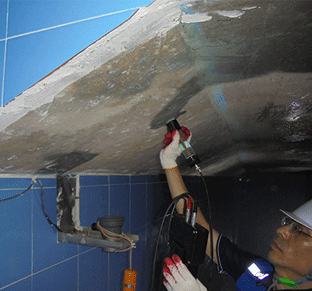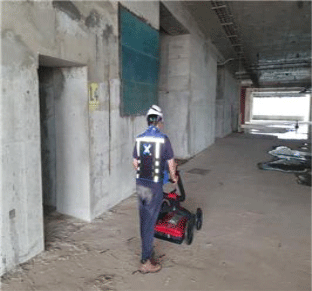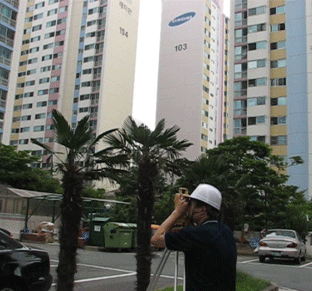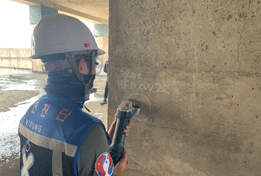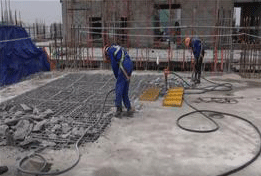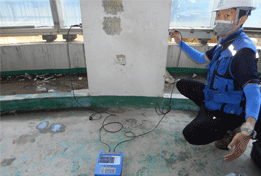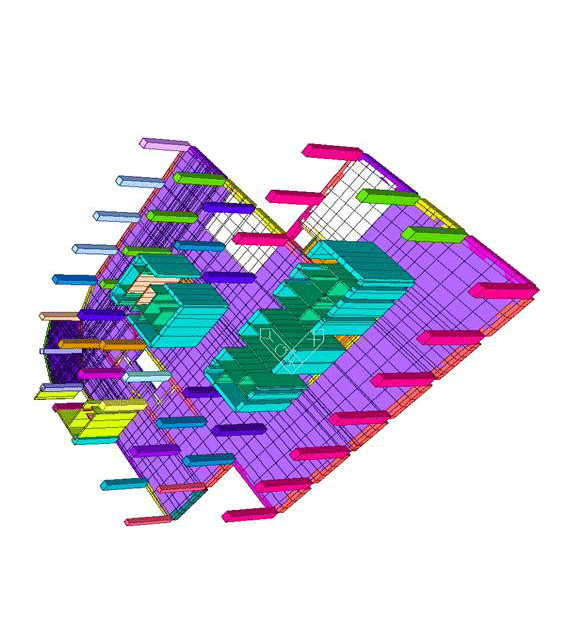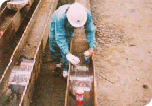
Comprehensive Safety Diagnosis
-
Safety diagnosis of the construction
Design book
-Common(completion details, construction specifications, various statement, soil quality survey reports, and other specific reports)
-Design drawings(common, civil engineering, construction)Construction related data
-Construction related data
-Quality management related data (records of various tests such as material certificate, quality test record, management and selection test record)
-Measurement-related data on major structural parts of facilities
-Accident record
-Port facility operation record -
Foundation subsurface check
Subsurface exploration and found check
Soil test
Execution work or not of the pile, depth of the penetration, bearing or not
-
Visual inspection, Condition measurement
Examination of a use and structure change
Differential settlement and deformation check
Crack check
Examination of concrete deterioration phenomenon
Steel strain check
Examination of steel deterioration phenomenon
Deformation examination with macroscopic observation
Reinforcement corrosion check
Steel splice condition check
Incidental institution condition check
Environments check
Slope investigation
-
Quality test concrete
Repulsion hardness test
Ultrasonic test
Neutralization test
Compressive strength test
Salt quantity test
Mixed proportion analysis
Elastic modulus survey
Absorption ratio check
Reinforcement arrangement condition and corrosion condition check
-
Quality test of steel
Steel thickness survey
Paint thickness survey
Inspection of welding defects VT, RT, MT, UT, PT
Hardness test
Tension strength test
Inspection of steel construction

-
Load carrying capacity test
Load carrying capacity test
Static strain survey
Vibration survey
-
Total analysis of measured result
Comprehensive review of load capacity and structure
-
Total report writing
Condition and safety valuation
Presentation of complement and reinforcement plan
Existence or not of using limit· using prohibition
Conclusion of reconstruction or not
-
The various test for other safe diagnosis
- The principle of reinforcement detecting method is to use the electromagnetic field when the regular alternating current of vibration in basis of the tamping of parallel resonance is sent along the coil of probe. That is, if the metal object is in the electromagnetic field, the volt handed to probe depends on the overlay thickness and size of method. What to grasp the difference of changing voltage, mark the value and picture dealer is the principle of reinforcement detecting instrument.
The basic principle of the reinforcement detecting method
- (The presumption by sulfuric copper solution, an electrolyte)
The corrosion measuring method of reinforcement in the concrete is to measure the electric current of mill volt unit generated from the difference or place between the reinforcement (metal material in the concrete) and concrete. That is to say, if the metal in the concrete is corroded by the electrolyte of sulfuric copper solution, a little electronic value of mill volt unit shows and the place of corrosion in the concrete is measured perceiving this electronic value.
- For the measurement using the reinforcement corrosion detecting instrument, the concrete must be wet 24 hours before measuring. - After putting a little sulfuric copper in Electrode Rod measuring the current and filling up the solution, we put the sulfuric copper and water in wheel Rod again connect the cable with substance, move slowly, and measure.
The method of reinforcement corrosion measure
-
The method of concrete salinity measuring
◎ The influence that the salinity effect on the reinforcement concrete
The chloride existing in the concrete corrodes the reinforcement in concrete or P.C. steel member and affects on the concrete structure. Usually, the dense concrete contains high alkaline by cement, so the immobile film of 20-60*10-10M on the surface of steel member forms and the steel member doesn't corrode well. However, if the chloride ion (Cl-) in the concrete exceeds the regular quantity, the immobile film is destroyed partly and the steel member corrodes.
When the immobile film is destroyed, the surface electric potential of metal due to the difference between the salinity and alkaline concentration, the difference of various density, or chemical heterogeneity of reinforcement and steel member surface forms the Anode and Cathode, send the electric current and corrode. And the volume of rust due to corrosion of steel member, Fe(OH)3, is larger than that of original steel member, so the crack occurs because of the swelling press.
After all, the crack of concrete makes the supply of oxygen and water easy and has corrosion of steel member progress fast, and also a decrease of square of steel member, a decrease of diameter of reinforcement causes the decline of durability of member. -
Test of the chloride content in concrete
The testing method of chloride content in concrete is divided into the survey of chloride against live concrete and the survey of chloride in the concrete. The former is used on the method that chlorine ion concentration contained the liquefaction of concrete is multiplied by unit quantity.
The measurement of chloride of live concrete
ⓐ To prepare measurement by using the concrete standard liquor of 0.2% or 0.02%
ⓑ To fabricate after making fill up to the pressure bowl
ⓒ Salinity weight (kg/m2) of CI ion should be marked.
The measurement of chloride of stiff concrete
ⓐ The mixed rate of fine aggregate, cement absorbed water isn't clear in hardened concrete. So the result of experimentation is come out as a liquor conversion rate
ⓑ The calculative method of the measuring result The 50% salt of soluble salinity is run out on analysis explanation table (a civil academy is Japan) of contained salinity in hardened concrete.
※ Please refer to the data room for more information about non-destructive testing.
